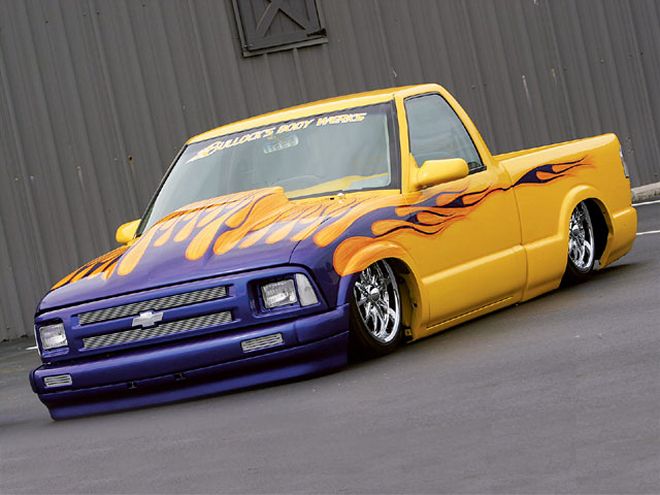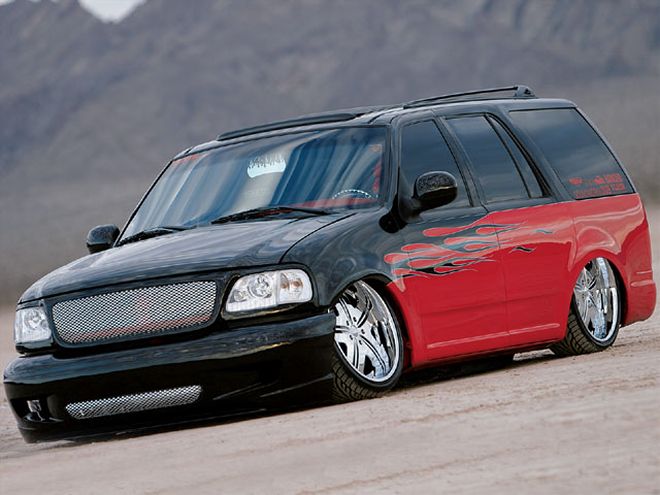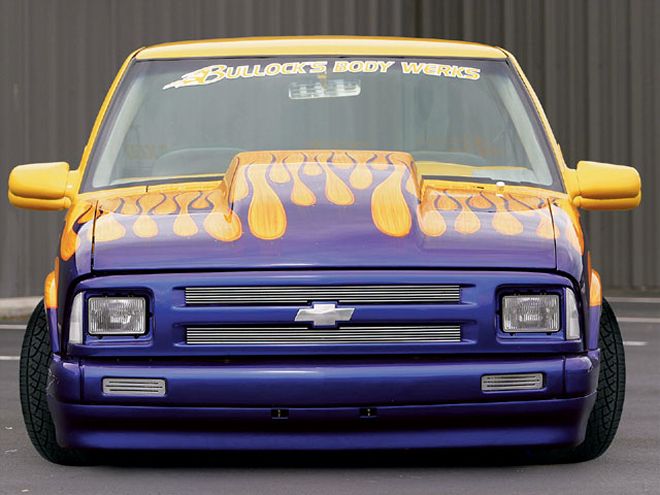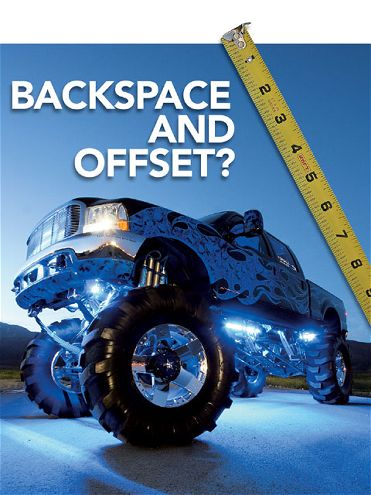
| wheel Backspace And Offset logo
Are you interested in buying a new set of wheels for your ride? We'll bet that you already spotted some cool wheels by cruising the shows, flipping through Truckin' and catalogs, peeking in stores, surfing websites, and talking with your friends. You know the style of the wheel, and the diameter, but will the wheels fit? While the diameter of a wheel fires the imagination-you just gotta have 24s filling the wheel wells, right?-the backspace or offset of a wheel are necessary for determining how a wheel will fit inside of your fender. Most wheels' product descriptions include backspace and/or the offset, along with width and diameter. But,
what is backspace and its cousin, offset, all about?
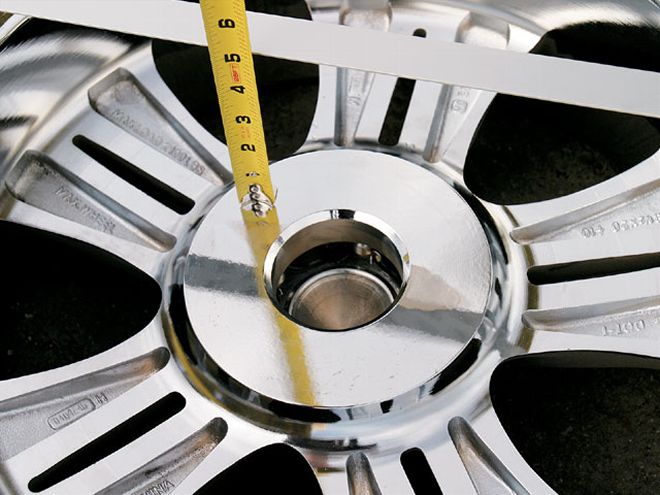
| wheel Backspace And Offset closeup View Measuring
Here's an explanation of what backspace and offset mean. Backspace is the distance from a wheel's mounting surface to the back edge of the wheel in inches. By "back" we mean the brake side of the wheel. Offset measures the distance from the mounting surface of the wheel to the centerline of the wheel, and it is often indicated in millimeters. If the mounting surface is located closer to the street side of a wheel, then the offset is positive. If it is located closer to the brake side of wheel, then the offset is negative. If it is in line with the center of the wheel, then the offset is zero.
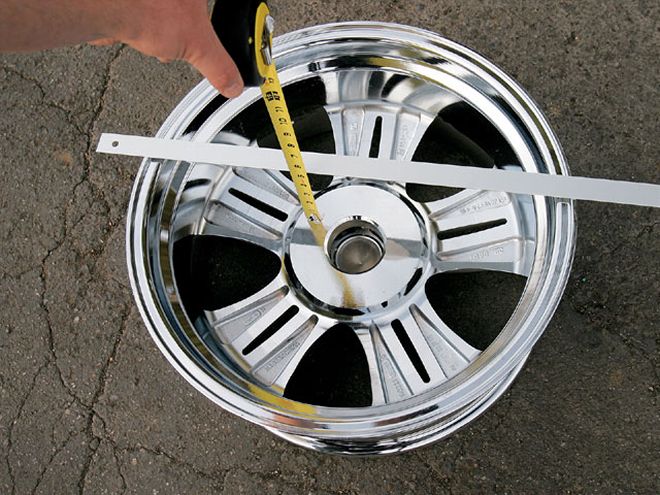
| wheel Backspace And Offset wide Shot Measuring
An example may simplify this: The centerline of a 10-inch-wide wheel is at five inches. If the wheel has a 6-inch backspace, then the offset is positive. Conversely, a 4-inch backspace would make the offset negative. A wheel that has a positive offset-or greater backspace-has to slide further into the wheel well to be mounted. Similarly, one with a negative offset-or lesser backspace-will tend to jut closer, or even beyond the fenders. By the way, spacers can be used to change the offset, as well. They slide over the wheel studs, sandwiching between the wheel and hub, creating negative offset, in a way, and thereby widening the track of the vehicle. Off-roaders often use this approach.
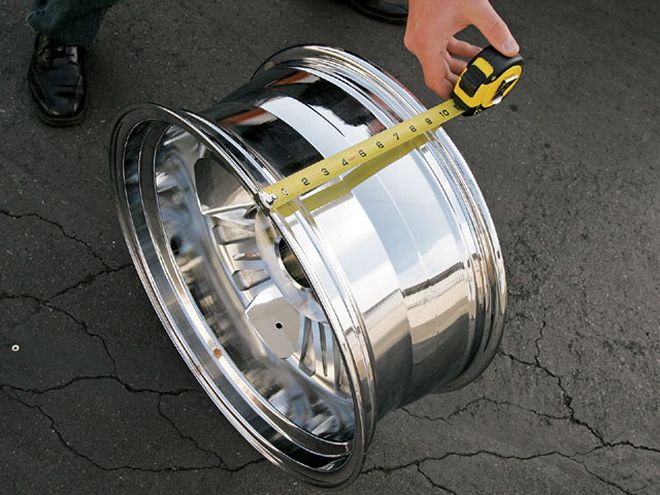
| wheel Backspace And Offset measuring Width
If you want to slam your suspension and tuck your tires, then it makes sense that you would lean toward a wheel with a positive offset (more backspace). But a negative offset (less backspace) might give you the room you need for that lifted look with big, knobby tires. There are other considerations, as well. If you have too little backspace, then a wheel is more likely to rub the brakes-or the suspension components. However, too much backspace and your tires may rub the fenders.
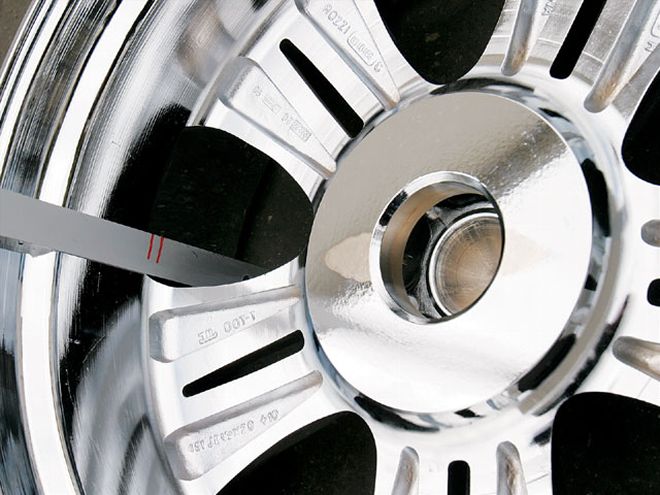
| wheel Backspace And Offset backspace
As you can see, backspace and offset are closely related. As we said before, many manufacturers have done the work for you by using both measurements in their product descriptions. Want to know how to calculate them on your own? Our sidebars will show you how to do just that.
Quick EquationsHere are some crib notes for figuring out backspace, centerline, and offset.
* Step 1: Measure the room in your wheel wells relative to the wheel hub.
* Step 2: Backspace = The distance from back of the wheel to the wheel's mounting space, in inches.
* Step 3: Centerline = The wheel width divided by 2, in inches.
* Step 4: Offset = Backspace - Centerline, which will be positive or negative, in inches.
* Step 5: Offset in Millimeters = Offset x 25.4.]
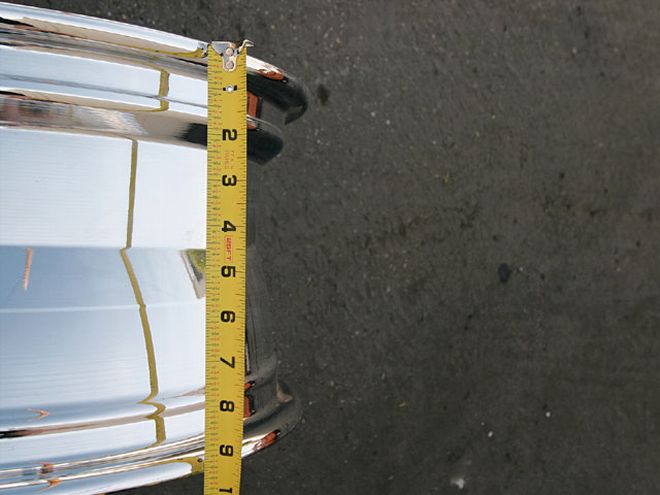
| wheel Backspace And Offset width Closeup
What Is My Wheel's Backspace?To determine the wheel's backspace, lay the wheel flat on the ground with the back facing upward. Next, lay a straightedge across the wheel and measure the distance from the back of the mounting surface to the strait edge. The backspace of the wheel pictured here is 5.25 inches. We calculated the wheel's offset in the quick equations.
What is My Truck's Backspace?You can measure how much space your truck has for wheels by making all your suspension, brake, and fender mods first. Then, simply measure the distance from the wheel hub on the spindle/axle back toward the first obstruction, such as your tie rods, etc. This will give you an idea of how much wheel backspace your truck can handle. Measure from the hub to the fender to find the amount of front space you can handle there, too. Next, we will calculate a wheel's backspace.
What Is My Wheel's Offset?To find the offset, start by determining the wheels' centerline. To obtain that, first measure the wheel's overall width from one outside edge to the other. Do note, that's not necessarily the same as the width given in the manufacturer specs. For example, the width in 20x8.5 inches refers to the distance between the inner flange and outer flange. Next, divide the width in inches by 2 to find the centerline. The width of this wheel is 9.5 inches, so its centerline is at 4.75 inches. Then, subtract the centerline value from the backspace value to find your offset in inches (5.25-4.75=.5). If the resulting number is negative, then your offset is negative, and the opposite goes for a positive offset. If the centerline value and backspace are the same, then the offset is zero. Don't forget, this number is still in inches. To convert, multiply it by 25.4 to get the offset in millimeters. The offset of this wheel is +.5 inch or +12.2 mm. Our result is a few millimeters from the manufacturer's listed offset. We tried to illustrate the offset in the photo that shows the two lines drawn on a straightedge, which indicates the position of the wheel's mounting surface to its centerline. We recap the equations we used to get backspace and offset in the following quick equations.
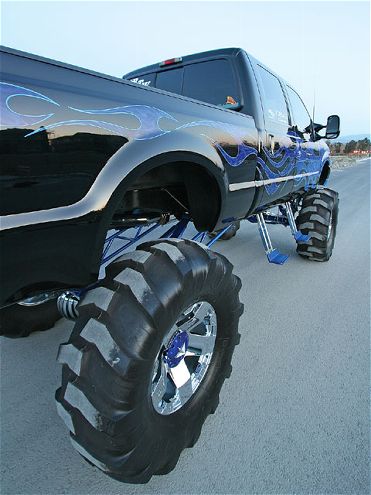
| wheel Backspace And Offset negative Offset
What Do Positive and Negative Look Like?Negative offset configurations are often found on lifted trucks and look badass. On the other hand, negative offset on a lowered truck can look just plain bad. Take a look at these three trucks. A lifted one's offset can make the wheels stick out-in order to clear those big tires.
 | wheel Backspace And Offset logo
Are you interested in buying a new set of wheels for your ride? We'll bet that you already spotted some cool wheels by cruising the shows, flipping through Truckin' and catalogs, peeking in stores, surfing websites, and talking with your friends. You know the style of the wheel, and the diameter, but will the wheels fit? While the diameter of a wheel fires the imagination-you just gotta have 24s filling the wheel wells, right?-the backspace or offset of a wheel are necessary for determining how a wheel will fit inside of your fender. Most wheels' product descriptions include backspace and/or the offset, along with width and diameter. But, what is backspace and its cousin, offset, all about?
| wheel Backspace And Offset logo
Are you interested in buying a new set of wheels for your ride? We'll bet that you already spotted some cool wheels by cruising the shows, flipping through Truckin' and catalogs, peeking in stores, surfing websites, and talking with your friends. You know the style of the wheel, and the diameter, but will the wheels fit? While the diameter of a wheel fires the imagination-you just gotta have 24s filling the wheel wells, right?-the backspace or offset of a wheel are necessary for determining how a wheel will fit inside of your fender. Most wheels' product descriptions include backspace and/or the offset, along with width and diameter. But, what is backspace and its cousin, offset, all about?
 | wheel Backspace And Offset closeup View Measuring
Here's an explanation of what backspace and offset mean. Backspace is the distance from a wheel's mounting surface to the back edge of the wheel in inches. By "back" we mean the brake side of the wheel. Offset measures the distance from the mounting surface of the wheel to the centerline of the wheel, and it is often indicated in millimeters. If the mounting surface is located closer to the street side of a wheel, then the offset is positive. If it is located closer to the brake side of wheel, then the offset is negative. If it is in line with the center of the wheel, then the offset is zero.
| wheel Backspace And Offset closeup View Measuring
Here's an explanation of what backspace and offset mean. Backspace is the distance from a wheel's mounting surface to the back edge of the wheel in inches. By "back" we mean the brake side of the wheel. Offset measures the distance from the mounting surface of the wheel to the centerline of the wheel, and it is often indicated in millimeters. If the mounting surface is located closer to the street side of a wheel, then the offset is positive. If it is located closer to the brake side of wheel, then the offset is negative. If it is in line with the center of the wheel, then the offset is zero.
 | wheel Backspace And Offset wide Shot Measuring
An example may simplify this: The centerline of a 10-inch-wide wheel is at five inches. If the wheel has a 6-inch backspace, then the offset is positive. Conversely, a 4-inch backspace would make the offset negative. A wheel that has a positive offset-or greater backspace-has to slide further into the wheel well to be mounted. Similarly, one with a negative offset-or lesser backspace-will tend to jut closer, or even beyond the fenders. By the way, spacers can be used to change the offset, as well. They slide over the wheel studs, sandwiching between the wheel and hub, creating negative offset, in a way, and thereby widening the track of the vehicle. Off-roaders often use this approach.
| wheel Backspace And Offset wide Shot Measuring
An example may simplify this: The centerline of a 10-inch-wide wheel is at five inches. If the wheel has a 6-inch backspace, then the offset is positive. Conversely, a 4-inch backspace would make the offset negative. A wheel that has a positive offset-or greater backspace-has to slide further into the wheel well to be mounted. Similarly, one with a negative offset-or lesser backspace-will tend to jut closer, or even beyond the fenders. By the way, spacers can be used to change the offset, as well. They slide over the wheel studs, sandwiching between the wheel and hub, creating negative offset, in a way, and thereby widening the track of the vehicle. Off-roaders often use this approach.
 | wheel Backspace And Offset measuring Width
If you want to slam your suspension and tuck your tires, then it makes sense that you would lean toward a wheel with a positive offset (more backspace). But a negative offset (less backspace) might give you the room you need for that lifted look with big, knobby tires. There are other considerations, as well. If you have too little backspace, then a wheel is more likely to rub the brakes-or the suspension components. However, too much backspace and your tires may rub the fenders.
| wheel Backspace And Offset measuring Width
If you want to slam your suspension and tuck your tires, then it makes sense that you would lean toward a wheel with a positive offset (more backspace). But a negative offset (less backspace) might give you the room you need for that lifted look with big, knobby tires. There are other considerations, as well. If you have too little backspace, then a wheel is more likely to rub the brakes-or the suspension components. However, too much backspace and your tires may rub the fenders.
 | wheel Backspace And Offset backspace
As you can see, backspace and offset are closely related. As we said before, many manufacturers have done the work for you by using both measurements in their product descriptions. Want to know how to calculate them on your own? Our sidebars will show you how to do just that.
Quick Equations
| wheel Backspace And Offset backspace
As you can see, backspace and offset are closely related. As we said before, many manufacturers have done the work for you by using both measurements in their product descriptions. Want to know how to calculate them on your own? Our sidebars will show you how to do just that.
Quick Equations | wheel Backspace And Offset width Closeup
What Is My Wheel's Backspace?To determine the wheel's backspace, lay the wheel flat on the ground with the back facing upward. Next, lay a straightedge across the wheel and measure the distance from the back of the mounting surface to the strait edge. The backspace of the wheel pictured here is 5.25 inches. We calculated the wheel's offset in the quick equations.
What is My Truck's Backspace?You can measure how much space your truck has for wheels by making all your suspension, brake, and fender mods first. Then, simply measure the distance from the wheel hub on the spindle/axle back toward the first obstruction, such as your tie rods, etc. This will give you an idea of how much wheel backspace your truck can handle. Measure from the hub to the fender to find the amount of front space you can handle there, too. Next, we will calculate a wheel's backspace.
What Is My Wheel's Offset?To find the offset, start by determining the wheels' centerline. To obtain that, first measure the wheel's overall width from one outside edge to the other. Do note, that's not necessarily the same as the width given in the manufacturer specs. For example, the width in 20x8.5 inches refers to the distance between the inner flange and outer flange. Next, divide the width in inches by 2 to find the centerline. The width of this wheel is 9.5 inches, so its centerline is at 4.75 inches. Then, subtract the centerline value from the backspace value to find your offset in inches (5.25-4.75=.5). If the resulting number is negative, then your offset is negative, and the opposite goes for a positive offset. If the centerline value and backspace are the same, then the offset is zero. Don't forget, this number is still in inches. To convert, multiply it by 25.4 to get the offset in millimeters. The offset of this wheel is +.5 inch or +12.2 mm. Our result is a few millimeters from the manufacturer's listed offset. We tried to illustrate the offset in the photo that shows the two lines drawn on a straightedge, which indicates the position of the wheel's mounting surface to its centerline. We recap the equations we used to get backspace and offset in the following quick equations.
| wheel Backspace And Offset width Closeup
What Is My Wheel's Backspace?To determine the wheel's backspace, lay the wheel flat on the ground with the back facing upward. Next, lay a straightedge across the wheel and measure the distance from the back of the mounting surface to the strait edge. The backspace of the wheel pictured here is 5.25 inches. We calculated the wheel's offset in the quick equations.
What is My Truck's Backspace?You can measure how much space your truck has for wheels by making all your suspension, brake, and fender mods first. Then, simply measure the distance from the wheel hub on the spindle/axle back toward the first obstruction, such as your tie rods, etc. This will give you an idea of how much wheel backspace your truck can handle. Measure from the hub to the fender to find the amount of front space you can handle there, too. Next, we will calculate a wheel's backspace.
What Is My Wheel's Offset?To find the offset, start by determining the wheels' centerline. To obtain that, first measure the wheel's overall width from one outside edge to the other. Do note, that's not necessarily the same as the width given in the manufacturer specs. For example, the width in 20x8.5 inches refers to the distance between the inner flange and outer flange. Next, divide the width in inches by 2 to find the centerline. The width of this wheel is 9.5 inches, so its centerline is at 4.75 inches. Then, subtract the centerline value from the backspace value to find your offset in inches (5.25-4.75=.5). If the resulting number is negative, then your offset is negative, and the opposite goes for a positive offset. If the centerline value and backspace are the same, then the offset is zero. Don't forget, this number is still in inches. To convert, multiply it by 25.4 to get the offset in millimeters. The offset of this wheel is +.5 inch or +12.2 mm. Our result is a few millimeters from the manufacturer's listed offset. We tried to illustrate the offset in the photo that shows the two lines drawn on a straightedge, which indicates the position of the wheel's mounting surface to its centerline. We recap the equations we used to get backspace and offset in the following quick equations.
 | wheel Backspace And Offset negative Offset
What Do Positive and Negative Look Like?Negative offset configurations are often found on lifted trucks and look badass. On the other hand, negative offset on a lowered truck can look just plain bad. Take a look at these three trucks. A lifted one's offset can make the wheels stick out-in order to clear those big tires.
| wheel Backspace And Offset negative Offset
What Do Positive and Negative Look Like?Negative offset configurations are often found on lifted trucks and look badass. On the other hand, negative offset on a lowered truck can look just plain bad. Take a look at these three trucks. A lifted one's offset can make the wheels stick out-in order to clear those big tires.
